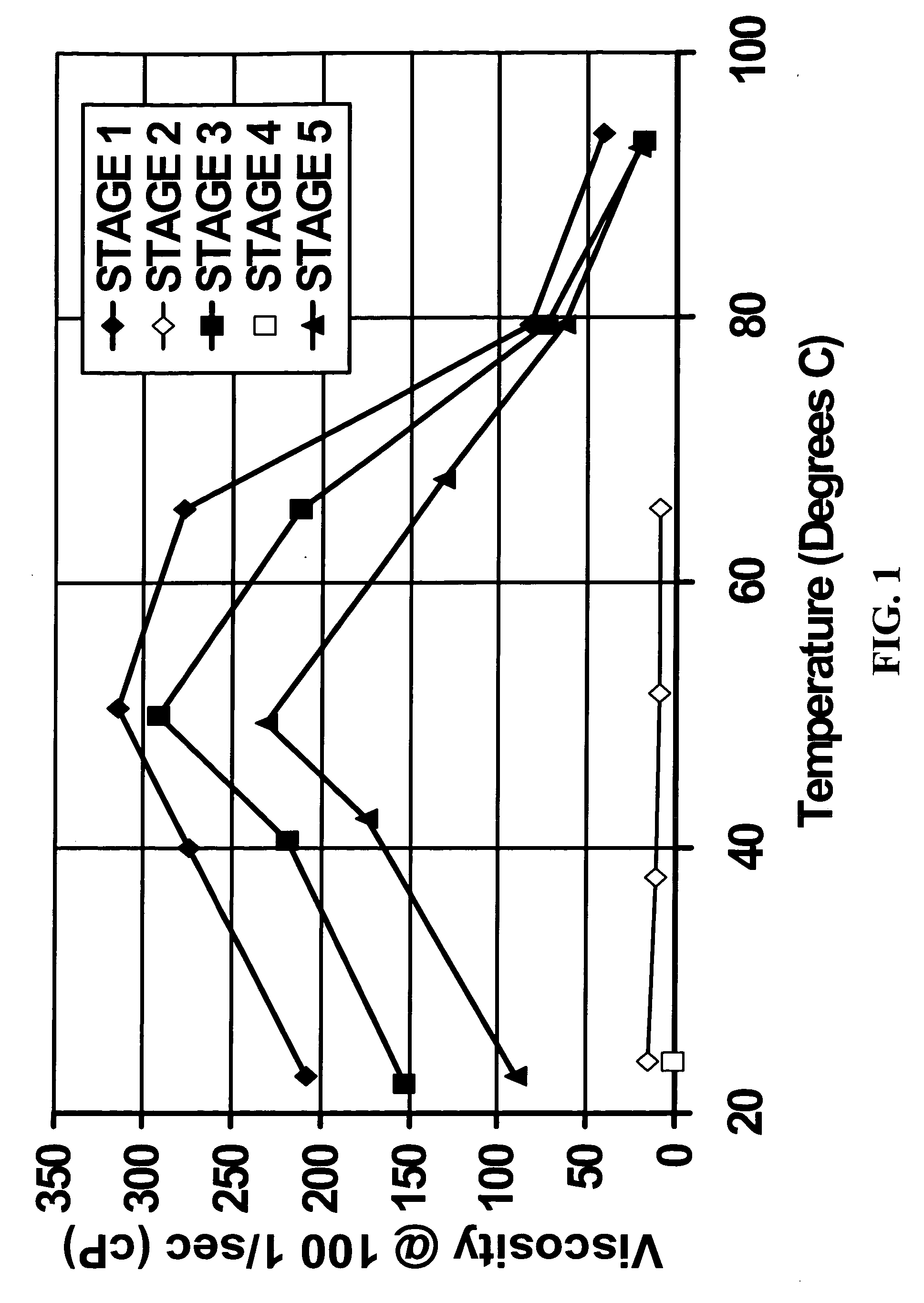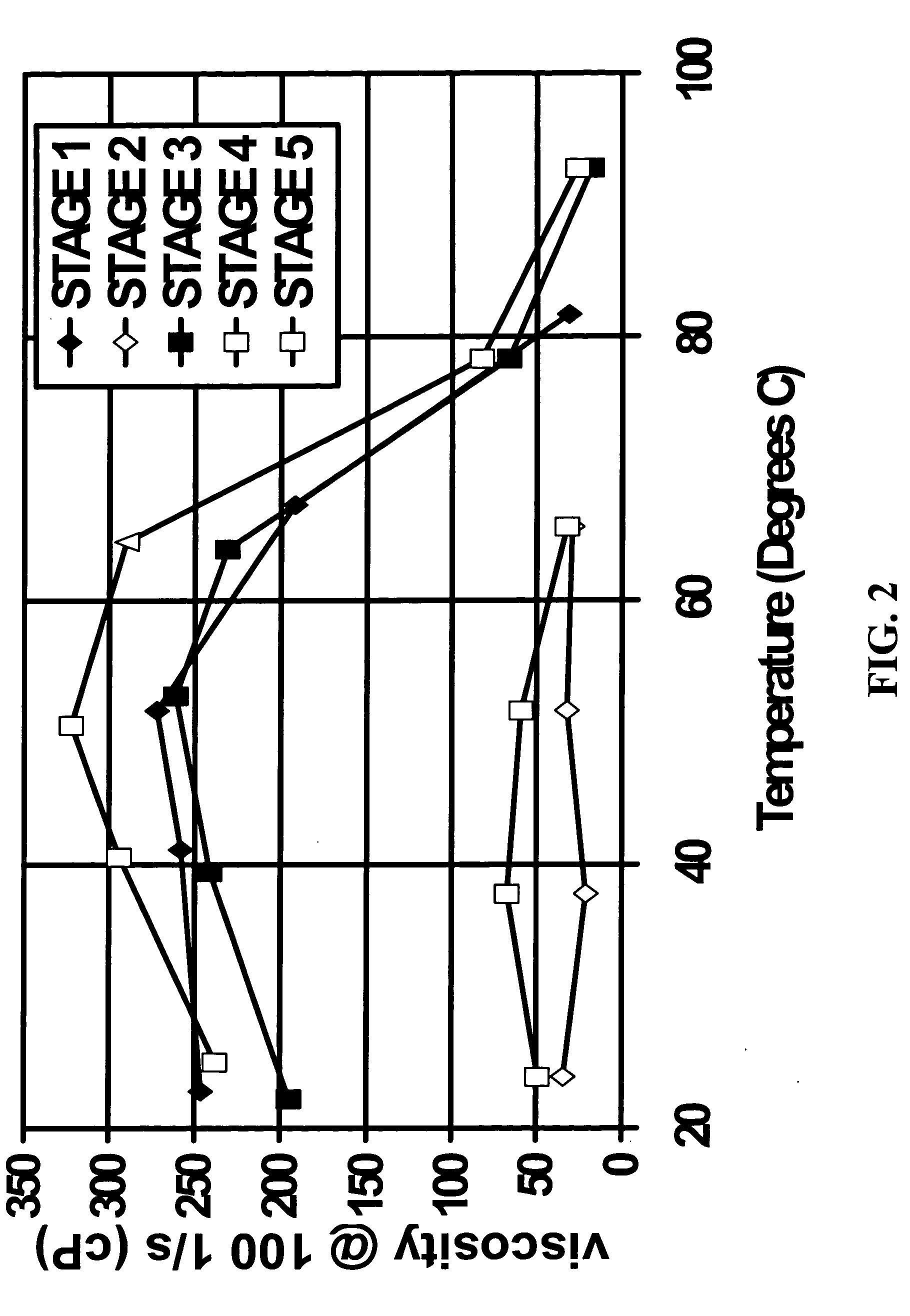Fluid having recyclable viscosity
- Summary
- Abstract
- Description
- Claims
- Application Information
AI Technical Summary
Benefits of technology
Problems solved by technology
Method used
Image
Examples
example 1
[0046] A 100 ml solution was made up in water with 4% oleic acid, 5% KCl, 0.4% EDTA and 2.5% of 30 wt % NaOH. The fluid had a pH of 12.62 and was a viscoelastic gel. The viscosity of this fluid as a function of temperature is shown in FIG. 1 as “Stage 1”. The fluid was then cooled and 0.75 ml of 37 wt % HCl was added; the fluid had a pH of 9.39 and very low viscosity, which is shown in FIG. 1 as “Stage 2”. The fluid was then cooled and 0.90 ml of 30 wt % NaOH was added; the fluid had a pH of 12.55 and was once again a viscous gel, which is shown in FIG. 1 as “Stage 3”. The fluid was then cooled and 0.75 ml of 37 wt % HCl was added; the fluid had a pH of 9.07 and very low viscosity, which is shown in FIG. 1 as “Stage 4”. The fluid was then cooled and 0.90 ml of 30 wt % NaOH was added; the fluid had a pH of 12.57 and was once again a viscous gel, which is shown in FIG. 1 as “Stage 5”. It is apparent that the fluid was repeatedly cycled between a fluid that could transport wellbore deb...
example 2
[0047] A 100 ml solution was made up in water with 4% oleic acid, 5% KCl, 0.4% EDTA and 2% of 45 wt % KOH. The fluid had a pH of 12.61 and was a viscoelastic gel. The viscosity of this fluid as a function of temperature is shown in FIG. 2 as “Stage 1”. The fluid was then cooled and 0.65 ml of 37 wt % HCl was added; the fluid had a pH of 9.35 and very low viscosity, which is shown in FIG. 2 as “Stage 2”. The fluid was then cooled and 0.85 ml of 45 wt % KOH was added; the fluid had a pH of 12.76 and was once again a viscous gel, which is shown in FIG. 2 as “Stage 3”. The fluid was then cooled and 0.65 ml of 37 wt % HCl was added; the fluid had a pH of 9.46 and very low viscosity, which is shown in FIG. 2 as “Stage 4”. The fluid was then cooled and 0.85 ml of 45 wt % KOH was added; the fluid had a pH of 12.78 and was once again a viscous gel, which is shown in FIG. 2 as “Stage 5”. It is apparent that the fluid was repeatedly cycled between a fluid that could transport wellbore debris a...
examples 3 and 4
[0048] Two sets of fluids were prepared. In the first set, the fluid was made up in water with 4% oleic acid, 0.4% EDTA, 2.5% of 30 wt % NaOH, and varying amounts (3%, 4%, 5%, 6%, 7%, and 8%) of KCl. The viscosity as a function of temperature of these fluids is shown in FIG. 3. In the second set, the fluid was made up in water with 4% oleic acid, 0.4% EDTA, 2% of 45 wt % KOH, and varying amounts (3%, 4%, 5%, 6%, 7%, and 8%) of KCl. The viscosity as a function of temperature of these fluids is shown in FIG. 4. It can be seen that there is an optimal KCl concentration and useful concentration range for each fluid and that the effect of an increase in KCl depends somewhat on whether there was initially any Na ion present. Simple experiments of this type should be used to optimize the compositions and methods of the invention as a function of the choice and concentrations of surfactant, salt, acid, and base to be used.
PUM
 Login to View More
Login to View More Abstract
Description
Claims
Application Information
 Login to View More
Login to View More - Generate Ideas
- Intellectual Property
- Life Sciences
- Materials
- Tech Scout
- Unparalleled Data Quality
- Higher Quality Content
- 60% Fewer Hallucinations
Browse by: Latest US Patents, China's latest patents, Technical Efficacy Thesaurus, Application Domain, Technology Topic, Popular Technical Reports.
© 2025 PatSnap. All rights reserved.Legal|Privacy policy|Modern Slavery Act Transparency Statement|Sitemap|About US| Contact US: help@patsnap.com



